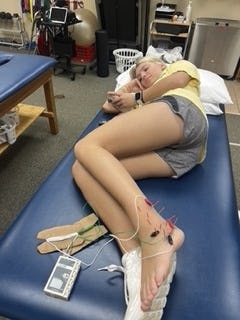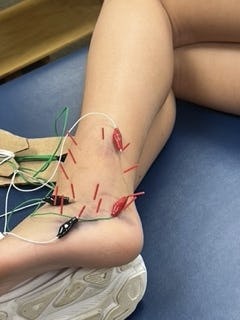JEFF W.

You don’t have to be a pro to be an athlete. If you run, you’re a runner. If you swim, you’re a swimmer. Whether you train to compete or simply train to be strong, there is nothing more devastating than an injury. Fortunately, our physical therapy team understands your unique needs and can help you recover from your sports injury as soon as possible. Contact Rehab Advantage & Sports Medicine to find out how.
What is a sports injury?
“Sports injury” is an all-encompassing term for an injury that happens during an athletic activity. You don’t have to be a professional or even a competitive athlete to develop a sports injury. Lifting heavy weights, running on ill-fitting shoes for too long, swinging a racket or golf club for years on end, or rolling your ankle on a soccer field can all lead to injury. The key to proper recovery is receiving appropriate treatment as soon as possible. The type and duration of your treatment will vary with how severe the injury is, your current health, and whether surgical intervention is required.

Types of sports injuries
While the type, location, severity, and cause of sports injuries are as varied as the sports themselves, the seven most common injuries are:
Sprain
A sprain happens when the ligaments that attach one bone to another are stretched beyond their capacity. While a mild ankle sprain tends to heal well on its own, once you have stretched those ligaments, you are more likely to re-injure your ankle a second or third time.
Strain or “Pulled Muscle”
Unlike a sprain that happens when one or more ligaments is stretched too far, a strain or “pull” happens when a tendon that attaches a muscle to a bone is stretched beyond its limits. Again, once the tendon is stretched, it is more likely you will experience a pull or strain again.
Shin splints
Pain in your shin bones is also known as “medial tibial stress syndrome” or shin splints. Usually caused by stress on your shinbone and the connective tissue that attaches there, shin splints are painful and often debilitating. Wearing proper footwear, warming up before exercise, and strengthening your core and leg muscles can often prevent this type of sports injury.
Shin splints
Pain in your shin bones is also known as “medial tibial stress syndrome” or shin splints. Usually caused by stress on your shinbone and the connective tissue that attaches there, shin splints are painful and often debilitating. Wearing proper footwear, warming up before exercise, and strengthening your core and leg muscles can often prevent this type of sports injury.
Knee injuries
Your knee is the most complex joint in your body. Whether you tear your ACL, develop a repetitive use injury in your kneecap or have a dull ache that runs from your hip to your knee, knee injuries are some of the most common sports injuries that can happen.
How physical therapy helps recovery after a sports injury
Think of a physical therapist as a movement specialist. These highly trained medical professionals can look at how you are moving your body and prescribe manual therapy, strengthening exercises, and stretches to help recover after or even prevent a sports injury. First, our physical therapist will take a detailed medical history including any prior surgeries, your current activity level, and any conditions that may have contributed to your injury. Next, they will do a thorough examination that may include X-rays, an MRI, or an ultrasound. Once our physical therapist has developed a treatment plan that is right for your injury, your physical fitness, your lifestyle, and your ability level, you will begin physical therapy.
Your treatment plan may include manual therapy to reduce scar tissue and increase range of motion, strengthening exercises to enhance not only the area that was injured but also the areas around your injury, stretches to improve mobility and balance, and pain management techniques. While physical therapy often begins and ends in our office, you will be given exercises, stretches, and exercises to do at home to enhance your recovery. Curious about whether or not physical therapy is right for your sports injury? Contact our office today to speak with our Dublin physical therapists and start on the road to recovery as soon as possible.
